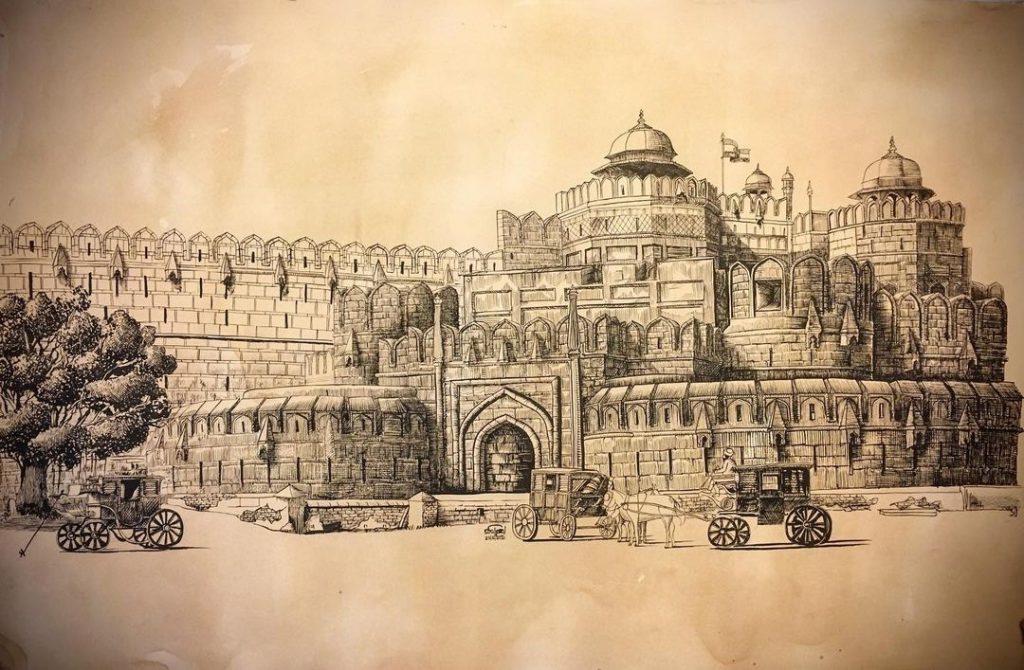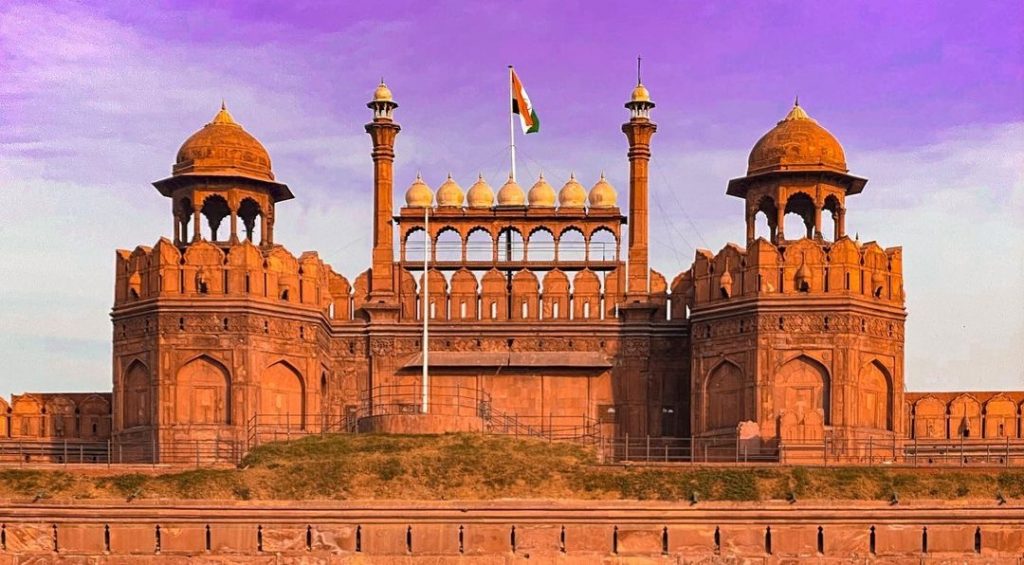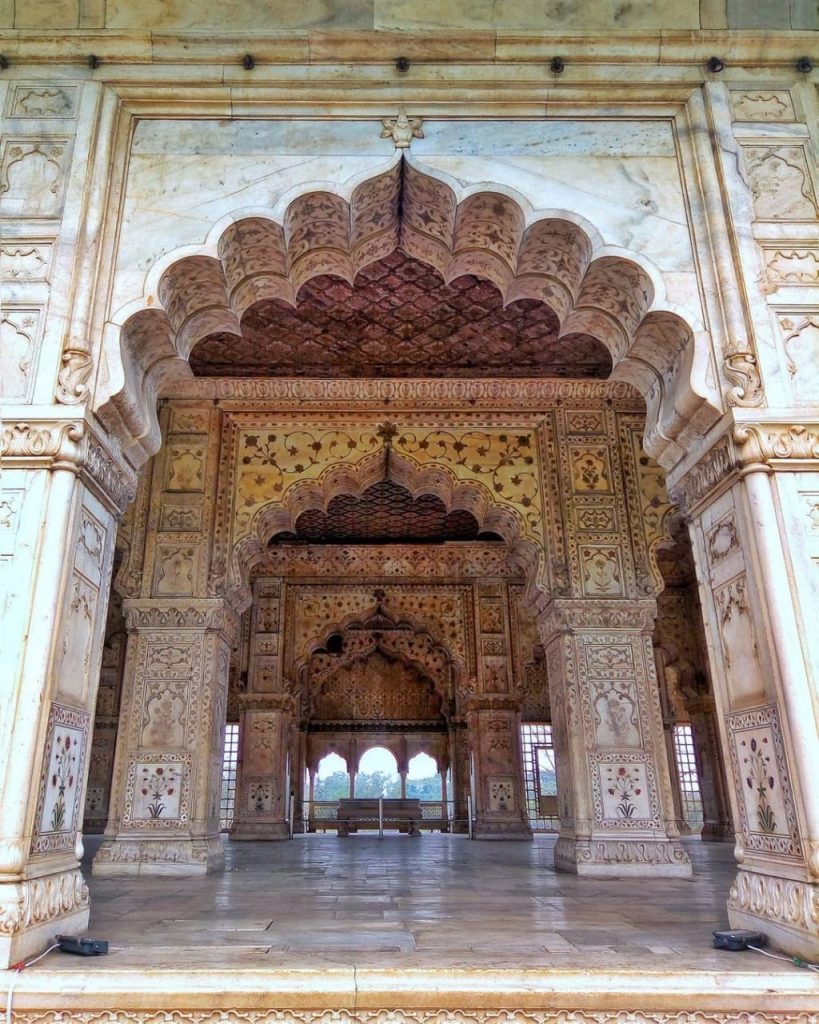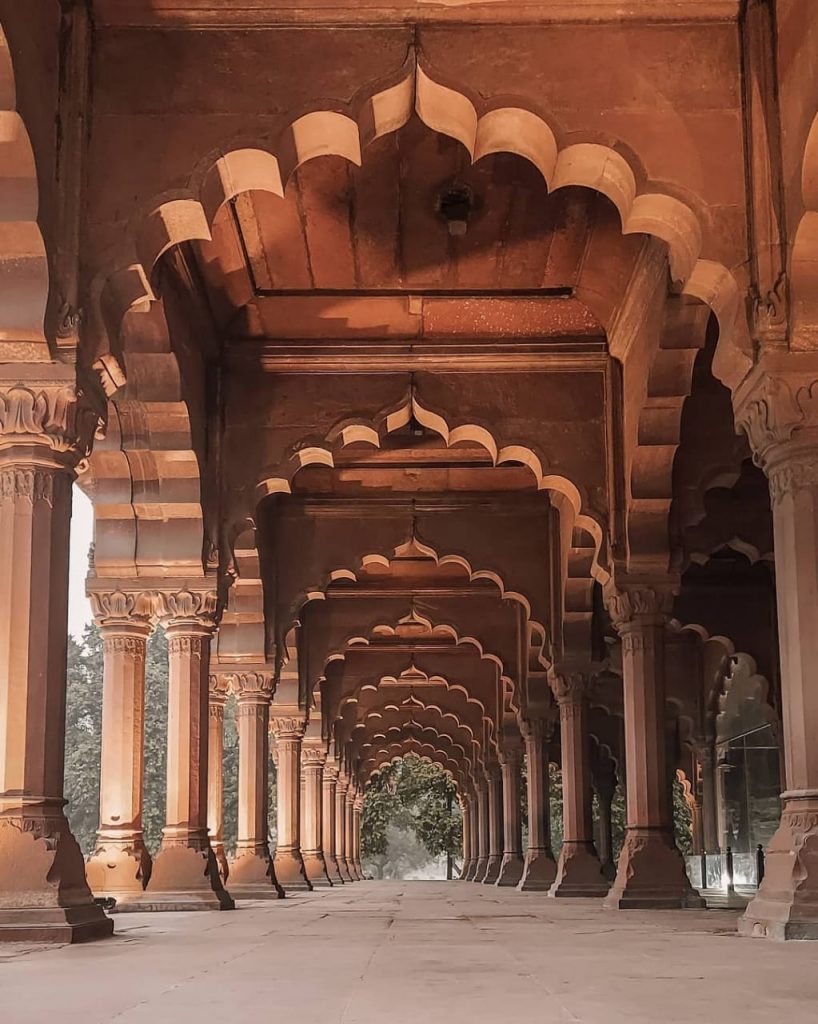Table of Contents
Red Fort, which was built by the Mughals dynasty had witnessed historical significance & changes in the course of Indian history. The place where our first Prime minister Pt. Jawahar Lal Nehru gave his famous speech, “the tryst with destiny” & continued to hoist the flag on the independence day every year with great celebration, yes this is the one and only Red Fort of Delhi.
The Red Fort is situated in Purani Delhi. The imposing monument is speechless yet it attracts a large number of tourists every year. The fort is surrounded by crowded lanes & chaos, that is full of life.
The Red fort was planned when emperor Shah Jahah thought to shift his capital from Agra to Shahjahanabad (present Delhi). The search for a place from Agra to Delhi ended at the river Yamuna.
Moreover, Emperor Shah Jahah had started the construction of the Red Fort by Anangpal Tomar on 12 May 1638. The architect of the fort was Ustad Ahmad Lahori (also constructed the Taj Mahal) and Hamid. It was then again renovated between April 1639 and April 1648. Also, the design of the fort was Indo-Islamic style.
Architectural History of Red Fort
The Red Fort is named for its beautiful architecture & design on walls of red sandstone. The Fort spread in an area of 254.67 acres of land. It is surrounded by 2.41 kilometres of defensive walls. Also punctuated by turrets and bastions situated at a height from 18 metres on the riverside to 33 metres on the city side.
Furthermore, Design is octagonal. The north-south axis is longer than the east-west axis of the fort. The marbled design, floral decorations & domes represent Mughal architecture.
The fort has five gates in total. The entrance gate is known as the Lahori gate which is also the main gate. The gate was designed with beautiful white marble & rec sandstone. Chandni Chowk is situated in front of the Lahori gate. The gate opened in the Chatta Chowk, also known as Meena Bazaar. The bazaar was started to show the wealth of the emperor. This world-famous bazaar has unique handicrafts & jewellery to attract lots of tourists attention.

In the south part of the fort, Delhi Darwaza is situated. It is opened into Jama Masjid. Emperor Shah Jahah used this gate to go to the mosque. In 1930, Lord Curzon built a statue of elephants on both sides of this gate. The east gate, which is the third gate of the fort used by Shah Jahan to go on the riverside.
The fort complex represents the zenith of Mughal creativity under Badshah Shah Jahan. Although the palace was planned according to Islamic prototypes, yet each pavilion contains a fusion of Persian, Timurid, and Hindu traditions, architectural design. The Red Fort’s imposing architectural style & garden design influenced the design of the building of Delhi, Rajasthan, Punjab, etc.
History of the structure inside the Red Fort
Red fort has a little world inside it. There were many beautiful architectures standing peacefully in the fort.

The Nakkare Khana
The Nakkar khana, built out of heartly carving of red sandstone. It is used for the announcement of important guests.
Deewan-e-Aam
Deewan-e-Aam is the place where emperors hear complaints & provide solutions to their people. It was initially made of red plaster & decorated with gold but later the gold was looted by invaders. In the centre of diwan-e-aam, a marble canopy with mesmerizing marble design is situated. This canopy is called nasheman-e-jhile-e-lahi, which means worship place. The wall behind this canopy has the finest architectural work. On the wall, the Greek god & beautiful Birds or animals are carved.
Diwan-e-Khas

Diwan-e-Khas is a big private audience hall. The famous Takht-e-taus was present here. It had the Kohinoor diamond which was later stolen by Nadir shah in 1739. Moreover, it is made entirely of gold with an imposing design of flowers & animals. The ceiling had beautiful paintings made of silver & gold but later it was melted & looted. According to shah Jahah, this place is Paradise to him. The famous poet ammer Khusro had written on the wall “Agar Firdaus bar-roo-e Jamie sat, Hami asth.” This means if there’s a paradise on the Earth, that place is this, this & this.
Beside the diwan-e-Khas
Beside the diwan-e-Khas, Badshah had his private mahal. The mahal is divided into three parts. These are the prayer place, the sleeping chamber & the resting place. An auctioneer tower was attached to a sleeping chamber which is used by Badshah for public darshan.
Rang Palace
The first palace in the Janam khana is Rang palace. It was used for entertainment purposes. It was divided by a water channel. The rooms are called sheesh mahal as the ceiling contains pieces of mirror.
Mumtaj Mahal
Besides Janam Khana, Mumtaj Mahal is situated in the southern part of it. Now this palace is used as a museum.
Shahi Humam
The Eastside of diwan-e-Khas had Shahi humam. This was the bathhouse of the royal family. The flooring of this magnificent bathhouse is fabulous.
Moti Masjid
Moti masjid was situated at the west side of sahi humaam. Emperor Aurangzeb created this mausoleum for his private use. When the sunlight falls on this white marble, it shines like a pearl.
Hayat Bagh
On the north side of the Moti Masjid, the Hayat bagh is situated. This char bagh is divided into squares with pathways & water running through the channel.
Jafar Mahal
Jafar mahal, in the centre of char bagh, has a great water channel, known as the Stream of Paradise.
Bholi
On the west side of the garden, a Bholi is situated. It is made from cutting rocks. It was believed that it was built before the Red Fort.
There are 3 museums situated in the Red fort.
History witnessed By the Red Fort

- The Jahandar Shah took over the Fort in 1712. The fort had been 30 years without an emperor. Emperor Saha was murdered & replaced within a year of his rule by Farrukhsiyar.
- In 1739, Persian Badshah Nadir Shah defeated the Mughals. He arrogated the Red Fort along with the Peacock Throne. After three months he returned to Persia. He left a destroyed city and a weakened Mughal empire to Muhammad Shah. Muhammad Shah was also called “Rangila” for his love for art.
- The weakness of the Mughal Empire made the Marathas the new king of the throne at Delhi.
- After that, the 1758 Maratha victory was aided by the Sikhs. The continuous defeat at Panipat kept them in further conflict with Ahmad Shah Durrani.
- In order to raise the funds in defence of Delhi from the armies of Ahmed Shah Durrani, the Marathas removed and melted the silver ceiling of the Diwan-e-Khas in 1760.
- In 1761, Marathas lost the third battle of Panipat. And, Ahmed Shah Durrani raided Delhi. Later, the Marathas captured Delhi from the Afghans under the leadership of Mahadji Scindia and Peshwa Madhavrao. The emperor Shah Alam II sat on the throne.
- During the Second Anglo-Maratha War, the British East India Company defeated the Maratha armies of Daulat Rao Scindia in the Battle of Delhi. This war ended the Maratha rule and their control upon the Red Fort.
- After the war, the British East India Company took over the Mughal territories and made a Resident at the Red Fort. The last Mughal emperor to occupy the fort was Bahadur Shah II. The Red Fort became a symbol of the 1857 movement against the British in which the residents of Shahjahanabad participated.
- The decline of the Mughal reign with the Aurangzeb left the degeneration of the palaces. The British authorized the plunder of valuables from the fort’s palaces. Afterwards, all furniture was removed or destroyed.
- The harem apartments, servants quarters and gardens were also destroyed. Moreover, a line of stone barracks was built. Only the marble buildings on the east side at the imperial was escaped from complete destruction. Although they were looted and damaged. While the defensive walls and towers were unharmed. Nearly two-thirds of the inner structures were destroyed by the British.
- After Indian Independence, few changes were made. The Red Fort continued to be used as a military cantonment. A significant part of the fort remained under Indian Army control until 22 December 2003.
- After that, it was given to the Archaeological Survey of India for restoration. In 2009 the Comprehensive Conservation and Management Plan (CCMP), prepared by the Archaeological Survey of India under Supreme Court directions to relieve the fort, was announced.
UNESCO World Heritage site

The Red fort gives a glimpse of the magnificent era of Indian history without utterly a word. Beautifully, It still stands straight with resilience, strength, power & integrity. Impressed by these red sandstone monuments, UNESCO declared the red fort a world heritage site.
Red Fort is totally a trip to paradise. We visit several places but only the experience stayed with us. Hope you enjoy the wonderful story of this beautiful monument.
(Travel Xamp is now on Telegram. Join our Telegram by clicking here to get all the travel hacks, destinations, blogs and travel news for free!)

One Response